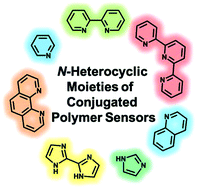Fluorescent chemosensors based on conjugated polymers with N-heterocyclic moieties: two decades of progress
Abstract
Among various fluorescent chemosensors based on different platforms, π-conjugated polymer-based sensors have attracted much attention, owing to their amplified detection sensitivity in the detection of a variety of environmental pollutants and bioactive compounds. Since the report of the first conjugated polymer sensor in the 90s, this sensing platform has achieved more than two decades of progress, with an explosion of the research in this field observed in the last ten years. In this review, we will focus on fluorescent polymer sensors with N-heterocyclic aromatic moieties, which have played a pivotal role since the beginning of the development of the conjugated polymer-based fluorescence sensing strategy. We will highlight the representative examples according to the different types of heterocycles, illustrate the structure–property relationships, point out the limitations and challenges of current systems, and also identify possible future research directions.



 Please wait while we load your content...
Please wait while we load your content...